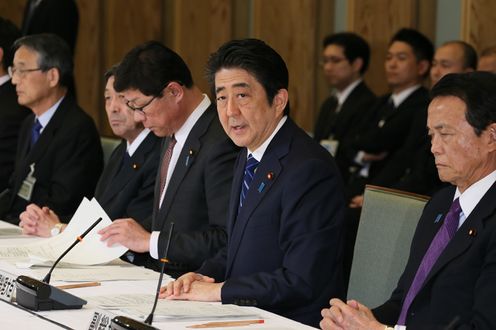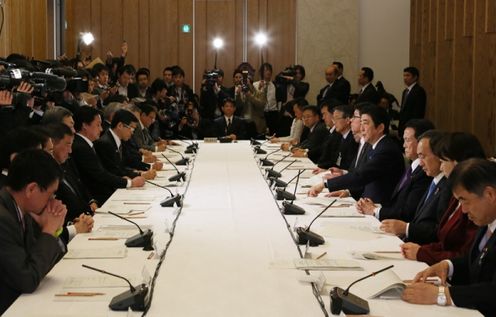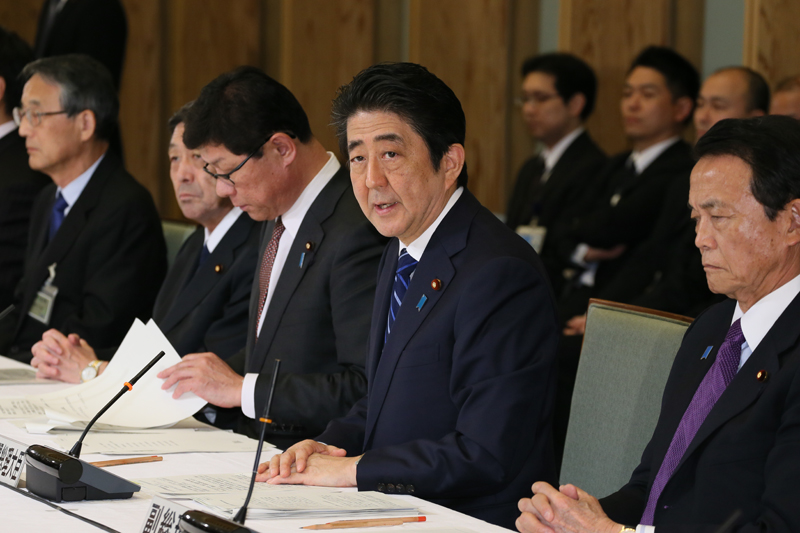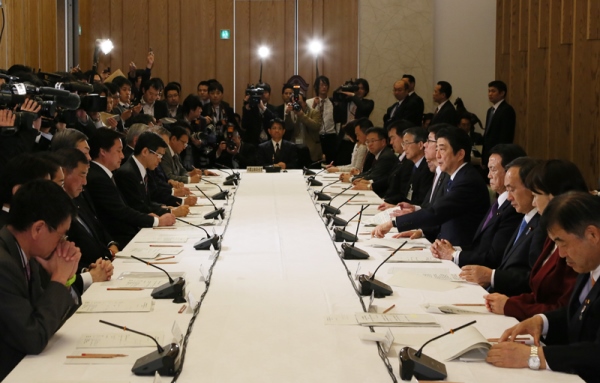Home > News > The Prime Minister in Action > March 2016 > Joint Meeting of the Reconstruction Promotion Council and the Nuclear Emergency Response Headquarters
The Prime Minister in Action
Joint Meeting of the Reconstruction Promotion Council and the Nuclear Emergency Response Headquarters
March 10, 2016

Photograph of the Prime Minister making a statement (1)

Photograph of the Prime Minister making a statement (2)
[Provisional Translation]
Prime Minister Shinzo Abe jointly held the 15th meeting of the Reconstruction Promotion Council and the 39th meeting of the Nuclear Emergency Response Headquarters at the Prime Minister’s Office.
During the joint meeting, reports were given on “the current situation and issues in the five years of reconstruction” and “the progress of the revision of the policy for accelerating Fukushima's reconstruction from the nuclear disaster.” Also, the “basic policy on reconstruction from the Great East Japan Earthquake in the reconstruction and revitalization period” was approved.
Based on the discussion in the meeting, the Prime Minister said,
“Tomorrow marks a full five years since the Great East Japan Earthquake. In advance of this anniversary, today we were able to finalize the basic policy for reconstruction within the second five-year ‘reconstruction and revitalization period.’
This new five-year period will set the stage for ‘finishing up’ the reconstruction of the earthquake and tsunami ravaged areas and the ‘true reconstruction’ of Fukushima.
During this period, with a strong resolution to achieve everything that is needed, we must realize a form of reconstruction that can become a model for regional revitalization by promoting seamless support for those affected by the disaster, the reconstruction of homes and towns, and the revitalization of employment.
For this reason, I am issuing the following two points in particular.
First, this new five-year period will be a battle of two challenges, remembering this disaster and combating harmful rumors. Through our daily steady efforts, we must increase momentum both in Japan and internationally to provide assistance to the affected areas.
This year, attention from Japan and abroad is focusing on this fifth anniversary of the disaster, and Japan is also serving as the chair of the G7 Summit. Given this opportunity, I would like the Minister for Reconstruction to take the lead in examining specific initiatives for improving the dissemination of information.
Second, reconstruction will not end with simple recovery; rather, it must be something tangible that paves the way for the future of Tohoku.
Therefore, we will restore tourism to Tohoku, which has fallen off dramatically since the earthquake and tsunami. We will further refine the resources of each region, which offer attractions such as nature, history, food and hot springs, among others, and make the region an appealing destination for people from around the world.
Although this will be no simple task, I ask that relevant ministers work closely with this region to devise innovative and bold tourism promotion measures unlike anything in the past.
As for Fukushima, I would like relevant ministers to work together to establish an environment for being able to lift the standing evacuation order a maximum of six years following the accident at the very latest, so that people who want to return home can do so as soon as possible. This applies to the Restricted Habitation Area and the Preparatory Zone for the Lifting of Evacuation Orders.
Measures to address water pollution and the decommissioning of the Fukushima Daiichi Nuclear Power Station are making solid progress. This can be attributed to the devoted efforts of the many workers who continue to bravely carry out their work despite a very harsh environment. Reactor decommissioning represents a long road ahead that will last upwards of 40 years. To encourage safe and steady decommissioning work and to honor the efforts of those giving their utmost on the frontlines, we will create a commendation program for teams who have achieved particularly excellent results. The government will continue to stand at the forefront of these efforts to safely decommission this facility.
Once again, I would like every minister to share the mindset that we are all Ministers for Reconstruction, and help in eliminating vertical segmentation, while also turning their attention to the frontlines, so that reconstruction can be completed in the affected areas at the earliest possible time during the reconstruction and revitalization period.”


